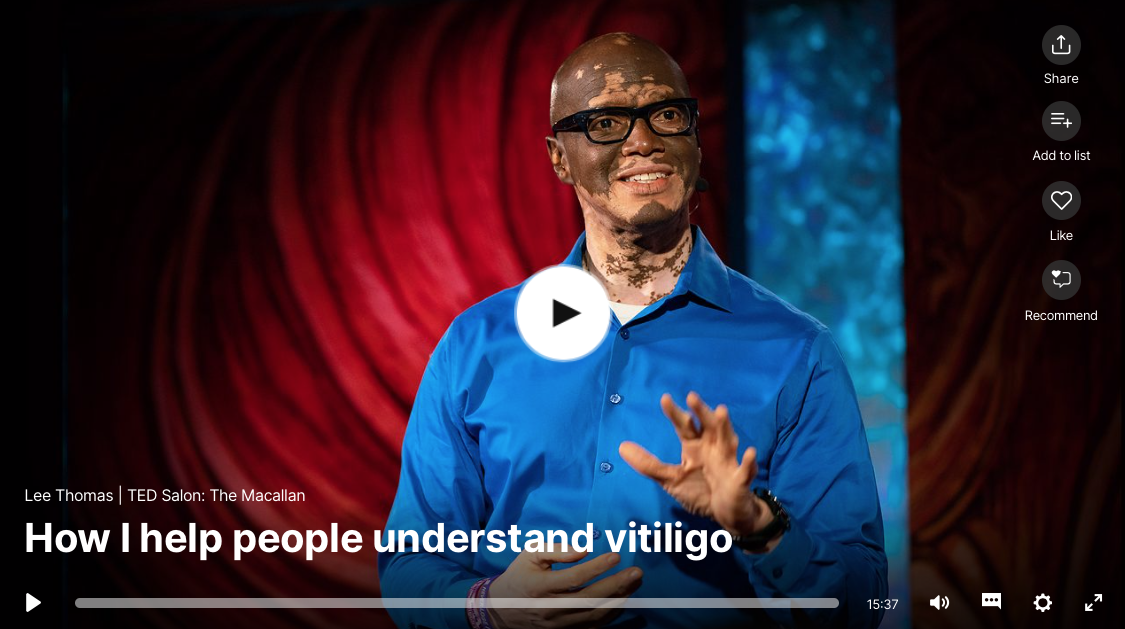New
Inspired by Unexpected Source, Newscaster Turns Vitiligo Upside Down
Lee Thomas first noticed white patches on his skin at the age of 25. When they began to spread, he was diagnosed with vitiligo, which—in his words—left him feeling “embarrassed, scared and lost.” Working in TV, on an entertainment show in Louisville, Kentucky, made things even worse, as he appeared in front of millions of people every day.
Lee’s solution to the problem was to hide his vitiligo with make-up. “I hid it for many years,” he recalls, “because by the time it got worse and started on my face, I was working in NYC at WABC TV—the number one station in the number one market in the US.” Lee essentially felt trapped by the industry. “The way I saw it, being on TV covering Hollywood, was the double-whammy of vanity. So it was a simple choice—either cover up or get out.”
Then, one day in 2005, Lee received a call from a child with vitiligo—a boy who wore a mask to go outside and play because he was worried about being teased. The boy had a simple request for Lee: ”If you could show people what you look like, maybe they will treat me differently,” the boy said.
In response, Lee went public about his condition. He put together a report for his new channel, WJBK Fox 2 Detroit, where he talked openly about his vitiligo for the first time. When Lee’s story hit the screen, it got the most feedback the channel had ever seen. Despite a few unpleasant emails and calls, the response was overwhelmingly positive. This inspired Lee to help others through motivational speaking and by writing a book, Turning White, that tells about his battle with the disease.
Despite everything, Lee sees many positives in having vitiligo. “In many ways this disease has been a blessing,” he says. “It has made me health conscious, humble, and grateful for what I have. It has stopped me from getting some jobs—I know this for a fact—but has also been a huge help professionally.”
Lee has found a way to turn his vitiligo into an opportunity. “Telling my story about living with vitiligo has let me show people the man I am: strong, honest, and loving. It has made me the most popular reporter in Detroit and given me a global platform,” he says. “There is not much more a reporter can ask for than that!”
Having nearly turned completely white, and restoring much of his natural skin color, he has a message for anyone else who suffers from vitiligo: “Don’t let this disease take your life away from you. Fight it, treat it, and find all the information you can. Just make sure you don’t shut yourself away—get out there and enjoy people and life. Don’t let vitiligo be a show stopper!”
Check out official website or watch this incredibly moving TED talk from 4x Emmy Award winner, Fox2 TV entertainment guru, and our best friend, Lee Thomas. His extremely personal talk explores the uncomfortable feeling of vulnerability familiar to every person with vitiligo, and suggests the way out of a daily stress.
P.S. If you haven't done so already, why not sign up to our monthly newsletter now, and never miss inspirational news like this one?
FAQOther Questions
- What is the best therapy for localized vitiligo?
Localized vitiligo, where the white patches are limited to one or a few areas of the body, can be managed with a few treatment approaches. The best therapy usually depends on th...
- Isn't it just a cosmetic disorder?
Contrary to popular belief, vitiligo is not merely a cosmetic issue but a complex autoimmune disorder that affects the body’s largest organ—along with other vital systems—and is...
- Is there a traditional medicine to treat vitiligo?
Traditional remedies can play a supportive role in managing chronic, metabolic, and stress-related conditions—particularly early in the disease process, before significant tissu...
Though it is not always easy to treat vitiligo, there is much to be gained by clearly understanding the diagnosis, the future implications, treatment options and their outcomes.
Many people deal with vitiligo while remaining in the public eye, maintaining a positive outlook, and having a successful career.
Copyright (C) Bodolóczki JúliaBy taking a little time to fill in the anonymous questionnaire, you can help researchers better understand and fight vitiligo.

